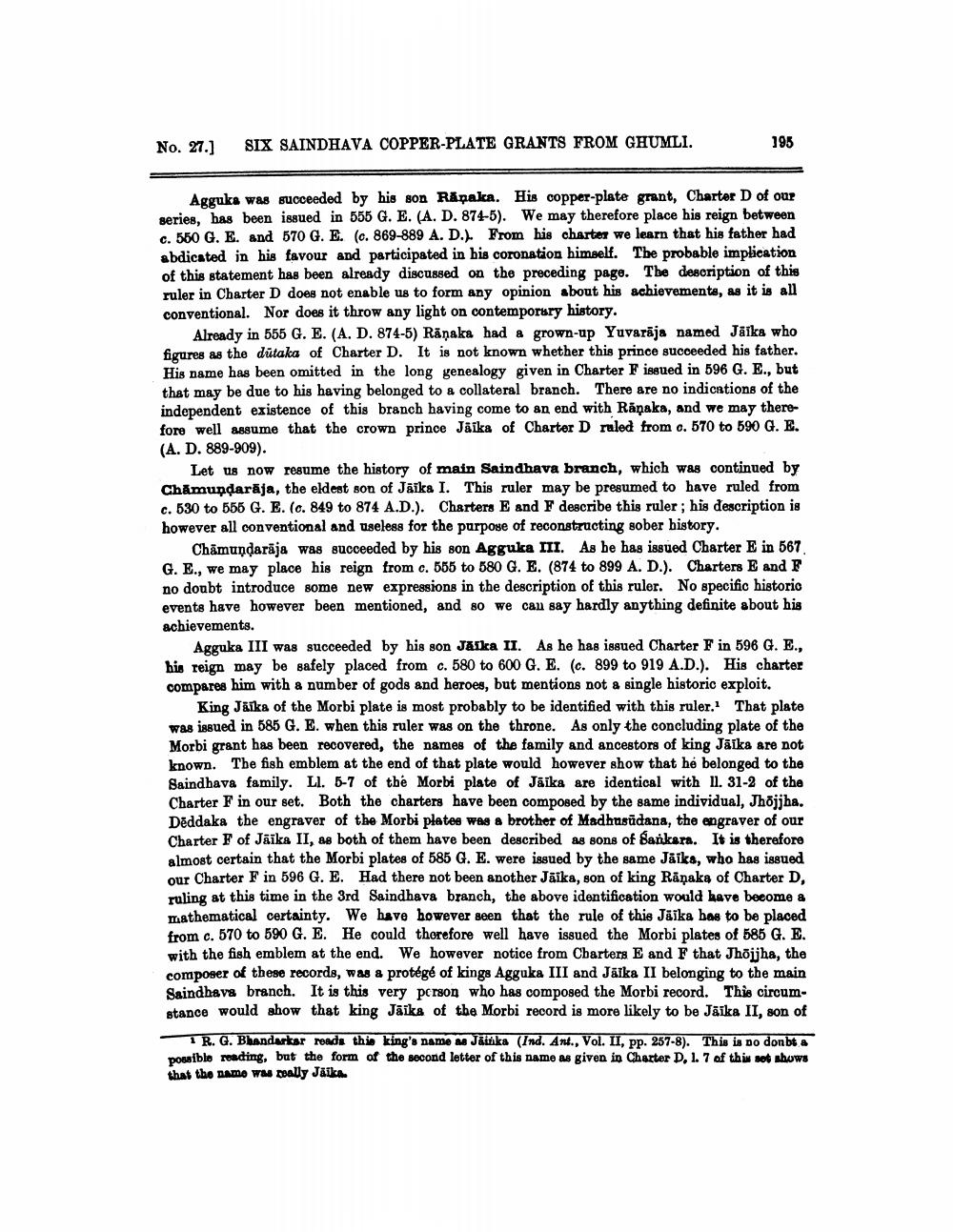________________
No. 27.]
SIX SAINDHAVA COPPER-PLATE GRANTS FROM GHUMLI.
195
Agguka was succeeded by his son Räpaka. His copper-plate grant, Charter D of our series, has been issued in 555 G. E. (A. D. 8745). We may therefore place his reign between c. 550 G. E. and 570 G. E. (c. 869-889 A. D.). From his charter we learn that his father had abdicated in his favour and participated in his coronation himself. The probable implication of this statement has been already discussed on the preceding page. The description of this ruler in Charter D does not enable us to form any opinion about his achievements, as it is all conventional. Nor does it throw any light on contemporary history.
Already in 555 G. E. (A. D. 874-5) Rāņaka had a grown-up Yuvarāja named Jāíka who figures as the dutaka of Charter D. It is not known whether this prince succeeded his father. His name has been omitted in the long genealogy given in Charter F issued in 596 G. E., but that may be due to his having belonged to a collateral branch. There are no indications of the independent existence of this branch having come to an end with Rāņaka, and we may therefore well 8.88ume that the crown prince Jäika of Charter D ruled from o. 570 to 590 G. E. (A. D. 889-909).
Let us now resume the history of main Saindhava branch, which was continued by Chămundarāja, the eldest son of Jāika I. This ruler may be presumed to have ruled from c. 530 to 556 G. E. (o. 849 to 874 A.D.). Charters E and F describe this ruler; his description is however all conventional and useless for the purpose of reconstructing sober history.
Chămundarāja was succeeded by his son Agguka III. As be has issued Charter E in 567 G. E., we may place his reign from c. 555 to 580 G. E. (874 to 899 A. D.). Charters E and F no doubt introduce some new expressions in the description of this ruler. No specific historio events have however been mentioned, and so we can say hardly anything definite about his achievements.
Agguka III was succeeded by his son Jāika II. As he has issued Charter F in 596 G. E., his reign may be safely placed from c. 580 to 600 G. E. (c. 899 to 919 A.D.). His charter compares him with a number of gods and heroes, but mentions not a single historic exploit.
King Jaika of the Morbi plate is most probably to be identified with this ruler. That plate was issued in 585 G. E. when this ruler was on the throne. As only the concluding plate of the Morbi grant has been recovered, the names of the family and ancestors of king Jāika are not known. The fish emblem at the end of that plate would however show that he belonged to the Saindhava family. LI. 5-7 of the Morbi plate of Jaika are identical with 11. 31-2 of the Charter F in our set. Both the charters have been composed by the same individual, Jhöjjha. Deddaka the engraver of the Morbi plates was a brother of Madhusudana, the engraver of our Charter F of Jāika II, as both of them have been described as sons of Sankara. It is therefore almost certain that the Morbi plates of 585 G. E. were issued by the same Jäiks, who has issued our Charter F in 596 G. E. Had there not been another Jāika, son of king Rāņaka of Charter D, ruling at this time in the 3rd Saindhava branch, the above identification would have become a mathematical certainty. We have however seen that the rule of this Jäska has to be placed from c. 570 to 590 G. E. He could thorefore well have issued the Morbi plates of 585 G. E. with the fish emblem at the end. We however notice from Charters E and F that Jhõijha, the composer of these records, was a protégé of kings Agguka III and Jāika II belonging to the main Saindhava branch. It is this very person who has composed the Morbi record. This circumstance would show that king Jäike of the Morbi record is more likely to be Jāika II, son of
1 R. G. Bhandarker reads this king's name as Jainka (Ind. Ant., Vol. II, pp. 257-8). This is no don bt a possible reading, but the form of the second letter of this name as given in Charter D, 1.7 of thin sot shows that the name was toally Jälka




